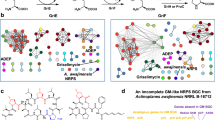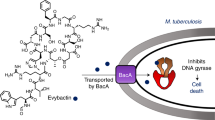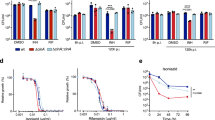Abstract
New chemotherapeutics active against multidrug-resistant Mycobacterium tuberculosis are urgently needed. We report on the identification of an adamantyl urea compound that shows potent bactericidal activity against M. tuberculosis and a unique mode of action, namely the abolition of the translocation of mycolic acids from the cytoplasm, where they are synthesized to the periplasmic side of the plasma membrane and are in turn transferred onto cell wall arabinogalactan or used in the formation of virulence-associated, outer membrane, trehalose-containing glycolipids. Whole-genome sequencing of spontaneous-resistant mutants of M. tuberculosis selected in vitro followed by genetic validation experiments revealed that our prototype inhibitor targets the inner membrane transporter MmpL3. Conditional gene expression of mmpL3 in mycobacteria and analysis of inhibitor-treated cells validate MmpL3 as essential for mycobacterial growth and support the involvement of this transporter in the translocation of trehalose monomycolate across the plasma membrane.
This is a preview of subscription content, access via your institution
Access options
Subscribe to this journal
Receive 12 print issues and online access
$259.00 per year
only $21.58 per issue
Buy this article
- Purchase on Springer Link
- Instant access to full article PDF
Prices may be subject to local taxes which are calculated during checkout





Similar content being viewed by others
References
World Health Organization. Global Tuberculosis Control – Epidemiology, Strategy, Financing (World Health Organization, 2009).
Global Alliance for TB Drug Development. Scientific blueprint for TB drug development. Tuberculosis (Edinb.) 81, 1–52 (2001).
Center for Disease Control and Prevention (CDC). Emergence of Mycobacterium tuberculosis with extensive resistance to second-line drugs worldwide, 2000–2004. MMWR Morb. Mortal. Wkly. Rep. 55, 301–305 (2006).
Schroeder, E.K., de Souza, O.N., Santos, D.S., Blanchard, J.S. & Basso, L.A. Drugs that inhibit mycolic acid biosynthesis in Mycobacterium tuberculosis. Curr. Pharm. Biotechnol. 3, 197–225 (2002).
Barry, C.E., Crick, D.C. & McNeil, M.R. Targeting the formation of the cell wall core of Mycobacterium tuberculosis. Infect. Disord. Drug Targets 7, 182–202 (2007).
Alahari, A. et al. Thiacetazone, an antitubercular drug that inhibits cyclopropanation of cell wall mycolic acids in mycobacteria. PLoS ONE 2, e1343 (2007).
Daffé, M. & Draper, P. The envelope layers of mycobacteria with reference to their pathogenicity. Adv. Microb. Physiol. 39, 131–203 (1998).
Barry, C.E. III et al. Mycolic acids: structure, biosynthesis and physiological functions. Prog. Lipid Res. 37, 143–179 (1998).
Dubnau, E. et al. Oxygenated mycolic acids are necessary for virulence of Mycobacterium tuberculosis in mice. Mol. Microbiol. 36, 630–637 (2000).
Glickman, M.S. Cording, cord factors and trehalose dimycolate. in The Mycobacterial Cell Envelope (eds. Daffé, M. & Reyrat, J.-M.) 63–73 (ASM Press, 2008).
Hoffmann, C., Leis, A., Niederweis, M., Plitzko, J.M. & Engelhardt, H. Disclosure of the mycobacterial outer membrane: cryo-electron tomography and vitreous sections reveal the lipid bilayer structure. Proc. Natl. Acad. Sci. USA 105, 3963–3967 (2008).
Zuber, B. et al. Direct visualization of the outer membrane of mycobacteria and corynebacteria in their native state. J. Bacteriol. 190, 5672–5680 (2008).
Vander Beken, S. et al. Molecular structure of the Mycobacterium tuberculosis virulence factor, mycolic acid, determines the elicited inflammatory pattern. Eur. J. Immunol. 41, 450–460 (2011).
Takayama, K., Wang, C. & Besra, G.S. Pathway to synthesis and processing of mycolic acids in Mycobacterium tuberculosis. Clin. Microbiol. Rev. 18, 81–101 (2005).
Gavalda, S. et al. The Pks13/FadD32 crosstalk for the biosynthesis of mycolic acids in Mycobacterium tuberculosis. J. Biol. Chem. 284, 19255–19264 (2009).
Lea-Smith, D.J. et al. The reductase that catalyzes mycolic motif synthesis is required for efficient attachment of mycolic acids to arabinogalactan. J. Biol. Chem. 282, 11000–11008 (2007).
Bhatt, A., Brown, A.K., Singh, A., Minnikin, D.E. & Besra, G.S. Loss of a mycobacterial gene encoding a reductase leads to an altered cell wall containing beta-oxo-mycolic acid analogs and accumulation of ketones. Chem. Biol. 15, 930–939 (2008).
Woodruff, P.J. et al. Trehalose is required for growth of Mycobacterium smegmatis. J. Biol. Chem. 279, 28835–28843 (2004).
Murphy, H.N. et al. The OtsAB pathway is essential for trehalose biosynthesis in Mycobacterium tuberculosis. J. Biol. Chem. 280, 14524–14529 (2005).
Tropis, M. et al. The crucial role of trehalose and structurally related oligosaccharides in the biosynthesis and transfer of mycolic acids in Corynebacterineae. J. Biol. Chem. 280, 26573–26585 (2005).
Kalscheuer, R., Weinrick, B., Veeraraghavan, U., Besra, G.S. & Jacobs, W.R. Jr. Trehalose-recycling ABC transporter LpqY-SugA-SugB-SugC is essential for virulence of Mycobacterium tuberculosis. Proc. Natl. Acad. Sci. USA 107, 21761–21766 (2010).
Besra, G.S. et al. Identification of the apparent carrier in mycolic acid synthesis. Proc. Natl. Acad. Sci. USA 91, 12735–12739 (1994).
Sathyamoorthy, N. & Takayama, K. Purification and characterization of a novel mycolic acid exchange enzyme from Mycobacterium tuberculosis. J. Biol. Chem. 262, 13417–13423 (1987).
Belisle, J.T. et al. Role of the major antigen of Mycobacterium tuberculosis in the cell wall biogenesis. Science 276, 1420–1422 (1997).
Jackson, M. et al. Inactivation of the antigen 85C gene profoundly affects the mycolate content and alters the permeability of the Mycobacterium tuberculosis cell envelope. Mol. Microbiol. 31, 1573–1587 (1999).
Puech, V. et al. Evidence for a partial redundancy of the fibronectin-binding proteins for the transfer of mycoloyl residues onto the cell wall arabinogalactan termini of Mycobacterium tuberculosis. Mol. Microbiol. 44, 1109–1122 (2002).
Sanki, A.K., Boucau, J., Ronning, D.R. & Sucheck, S.J. Antigen 85C-mediated acyl-transfer between synthetic acyl donors and fragments of the arabinan. Glycoconj. J. 26, 589–596 (2009).
Brown, J.R. et al. The structure–activity relationship of urea derivatives as anti-tuberculosis agents. Bioorg. Med. Chem. 19, 5585–5595 (2011).
Camacho, L.R. et al. Analysis of the phthiocerol dimycocerosate locus of Mycobacterium tuberculosis. Evidence that this lipid is involved in the cell wall permeability barrier. J. Biol. Chem. 276, 19845–19854 (2001).
Morisseau, C. & Hammock, B.D. Epoxide hydrolases: Mechanisms, inhibitor designs, and biological roles. Annu. Rev. Pharmacol. Toxicol. 45, 311–333 (2005).
Jain, M., Chow, E.D. & Cox, J.S. The MmpL protein family. in The Mycobacterial Cell Envelope (eds. Daffé, M. & Reyrat, J.-M.) 201–210 (ASM Press, 2008).
Domenech, P., Reed, M.B. & Barry, C.E. III. Contribution of the Mycobacterium tuberculosis MmpL protein family to virulence and drug resistance. Infect. Immun. 73, 3492–3501 (2005).
Tekaia, F. et al. Analysis of the proteome of Mycobacterium tuberculosis in silico. Tuber. Lung Dis. 79, 329–342 (1999).
De Rossi, E., Ainsa, J.A. & Riccardi, G. Role of mycobacterial efflux transporters in drug resistance: an unsolved question. FEMS Microbiol. Rev. 30, 36–52 (2006).
Saier, M.H. Jr. & Paulsen, I.T. Phylogeny of multidrug transporters. Semin. Cell Dev. Biol. 12, 205–213 (2001).
Murakami, S. Multidrug efflux transporter, AcrB–the pumping mechanism. Curr. Opin. Struct. Biol. 18, 459–465 (2008).
Sennhauser, G., Bukowska, M.A., Briand, C. & Grutter, M.G. Crystal structure of the multidrug exporter MexB from Pseudomonas aeruginosa. J. Mol. Biol. 389, 134–145 (2009).
Cox, J.S., Chen, B., McNeil, M. & Jacobs, W.R. Jr. Complex lipid determines tissue-specific replication of Mycobacterium tuberculosis in mice. Nature 402, 79–83 (1999).
Converse, S.E. et al. MmpL8 is required for sulfolipid-1 biosynthesis and Mycobacterium tuberculosis virulence. Proc. Natl. Acad. Sci. USA 100, 6121–6126 (2003).
Domenech, P. et al. The role of MmpL8 in sulfatide biogenesis and virulence of Mycobacterium tuberculosis. J. Biol. Chem. 279, 21257–21265 (2004).
Gilleron, M. et al. Diacylated sulfoglycolipids are novel mycobacterial antigens stimulating CD1-restricted T cells during infection with Mycobacterium tuberculosis. J. Exp. Med. 199, 649–659 (2004).
Tullius, M.V. et al. Discovery and characterization of a unique mycobacterial heme acquisition system. Proc. Natl. Acad. Sci. USA 108, 5051–5056 (2011).
Jackson, M., Stadthagen, G. & Gicquel, B. Long-chain multiple methyl-branched fatty acid-containing lipids of Mycobacterium tuberculosis: biosynthesis, transport, regulation and biological activities. Tuberculosis (Edinb.) 87, 78–86 (2007).
Jain, M. & Cox, J.S. Interaction between polyketide synthase and transporter suggests coupled synthesis and export of virulence lipid in M. tuberculosis. PLoS Pathog. 1, e2 (2005).
Jackson, M., Camacho, L.R., Gicquel, B. & Guilhot, C. Gene replacement and transposon delivery using the negative selection marker sacB. Methods Mol. Med. 54, 59–75 (2001).
Guo, X.V. et al. Silencing essential protein secretion in Mycobacterium smegmatis by using tetracyclin repressors. J. Bacteriol. 189, 4614–4623 (2007).
Korduláková, J. et al. Definition of the first mannosylation step in phosphatidylinositol synthesis: PimA is essential for growth of mycobacteria. J. Biol. Chem. 277, 31335–31344 (2002).
Stadthagen, G. et al. p-hydroxybenzoic acid synthesis in Mycobacterium tuberculosis. J. Biol. Chem. 280, 40699–40706 (2005).
Leistikow, R.L. et al. The Mycobacterium tuberculosis DosR regulon assists in metabolic homeostasis and enables rapid recovery from nonrespiring dormancy. J. Bacteriol. 192, 1662–1670 (2010).
Acknowledgements
This work was supported by the NIAID and NIH grants AI085992, AI063054 and AI057836; the American Lebanese Syrian Associated Charities; and the Slovak Research and Development Agency under contract no. APVV-0441-10. We thank R. Dhiman for helpful scientific discussions and D. Dick for LC/MS analyses. Purified recombinant FbpC (Ag85C) was kindly provided by K. Dobos (Colorado State University).
Author information
Authors and Affiliations
Contributions
A.E.G., A.J.L., J.K., R.E.L., M.R.M. and M.J. designed experiments. E.J.N. and C.M. synthesized compounds. A.E.G., H.P., V.A.K.B.G., M.S.S., V.J., T.H., S.S.C., J.K., S.E.M.B., V.G. and C.M. selected resistant mutants, constructed recombinant mycobacterial strains and performed MIC testing, enzymatic assays, metabolic labeling, lipid and mycolic acid analyses and genomic analyses. T.H. performed compound accumulation studies in M. tuberculosis. M.R.M., R.E.L. and M.J. wrote the paper.
Corresponding authors
Ethics declarations
Competing interests
The authors declare no competing financial interests.
Supplementary information
Supplementary Text and Figures
Supplementary Methods and Supplementary Results (PDF 3590 kb)
Rights and permissions
About this article
Cite this article
Grzegorzewicz, A., Pham, H., Gundi, V. et al. Inhibition of mycolic acid transport across the Mycobacterium tuberculosis plasma membrane. Nat Chem Biol 8, 334–341 (2012). https://doi.org/10.1038/nchembio.794
Received:
Accepted:
Published:
Issue Date:
DOI: https://doi.org/10.1038/nchembio.794
This article is cited by
-
Lsr2 acts as a cyclic di-GMP receptor that promotes keto-mycolic acid synthesis and biofilm formation in mycobacteria
Nature Communications (2024)
-
S288T mutation altering MmpL3 periplasmic domain channel and H-bond network: a novel dual drug resistance mechanism
Journal of Molecular Modeling (2024)
-
Therapeutically useful mycobacteriophages BPs and Muddy require trehalose polyphleates
Nature Microbiology (2023)
-
In vivo imaging of MmpL transporters reveals distinct subcellular locations for export of mycolic acids and non-essential trehalose polyphleates in the mycobacterial outer membrane
Scientific Reports (2023)
-
Study of SQ109 analogs binding to mycobacterium MmpL3 transporter using MD simulations and alchemical relative binding free energy calculations
Journal of Computer-Aided Molecular Design (2023)



